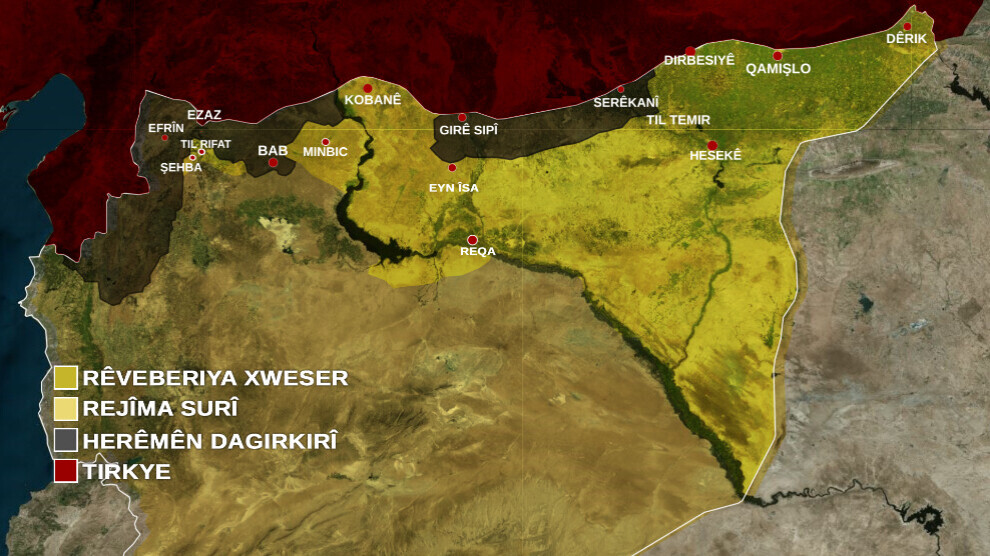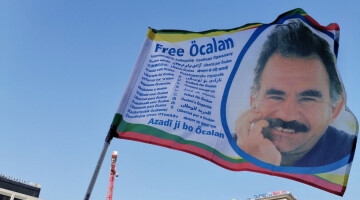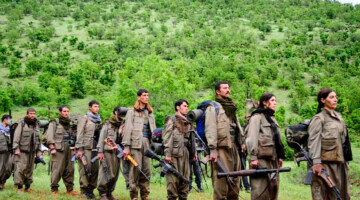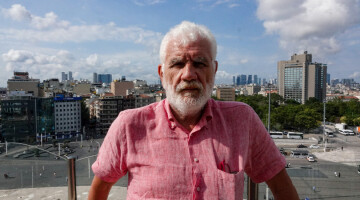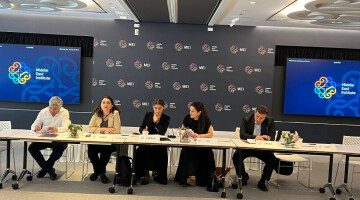The Turkish state has made war and chaos permanent in Syria, which it has been attacking since October 25, 2012. Frustrated by the Kurdish self-governments with the Rojava Revolution on July 19, 2012, the Turkish state introduced dozens of plans to attack these achievements of the Kurds. Turkey first wanted to realize its plans through Al-Nusra, an extension of Al-Qaeda. When this plan failed in the face of the Kurdish resistance, it started to support ISIS. Moreover, Turkey created a coalition of mercenary groups called the "Free Syrian Army". When this army also failed, Turkey deployed its own troops to Syria on August 24, 2016.
IT STARTED WITH AL-NUSRA
Al-Nusra announced its establishment by posting a video on January 23, 2012, and claimed its breakaway from Al-Qaeda. Those seeking to invade Rojava carried out their first attacks with Al Nusra on the Şêxmeqsûd (Sheikh Maqsoud) and Eşrefiye (Ashrafiyah) districts of Aleppo on October 25-26 in 2012, which claimed the lives of 30 Kurds. On October 27-30, they attacked Afrin villages. A week later, on November 8, Al-Nusra moved from the Ceylanpınar district of Urfa to Serêkaniyê, and tried to win over Arab citizens in the city, arguing that they were "against the Syrian regime and were in the region for an alliance". When its black propaganda was later exposed, it attacked Kurdish neighbourhoods in the city on November 19. The parliament Speaker, Ebid Xelîl, was killed in these attacks. YPG fighters started to counteract Al-Nusra, which continued to attack people in the city until January 2013. Al-Nusra was removed from the city following the armed clashes. Many documents that revealed their relations with Turkey were seized at their headquarters. Al-Nusra, which was later put onto the terror list, changed its name to the 'Fatah al-Sham Front' on July 28, 2016, and then, on January 28, 2017, to Hayat Tahrir Al-Sham (HTS) to restore strength.
THEY INTRODUCED ISIS
When Al-Nusra failed to succeed against the Kurds, ISIS was introduced on the ground in 2014. After invading Mosul and Shengal, ISIS started to attack many regions of North-East Syria. After Raqqa and Tabqa were occupied, ISIS launched intense attacks against Kobanê on the night of September 14. Rojava defence forces and the people of the region resisted the brutal attacks of ISIS with individual weapons and achieved victory in Kobanê, paving the way for ISIS’ defeat. The Rojava forces continued to fight ISIS until Manbij, Tabqa, Raqqa and ISIS' last stronghold of Baxoz (Baghouz), and thus ISIS' territorial domination was ended.
The Turkish state, which has supported ISIS since 2014, has planned numerous bomb attacks and massacres in the region. One of these attacks was carried out with a bomb-laden truck on July 27, 2016, in the Xerbî District of Qamishlo, which killed 62 people and injured 176 more.
TURKISH ARMY COMES INTO VIEW
Realizing its failure to achieve its goals through mercenary groups, the Turkish state deployed its own troops to the battlefields. It occupied the Syrian cities of Azaz, Bab and Jarablus on August 24, 2016 with an operation dubbed "Operation Euphrates Shield". In 2017, the Turkish state launched an invasion attack on Idlib, one of the largest cities in Syria. Turkey continues its efforts to completely capture Idlib, a part of which it has already occupied.
On January 20, 2018, an invasion attack dubbed 'Operation Olive Branch' was launched against Afrin. 72 fighter jets of the Turkish army carried out massacres against civilians, including children and the elderly. Following these attacks which killed thousands of people, Afrin was occupied on March 18, 2018, and more than 300 thousand people from Afrin were forced to migrate to the surrounding cities.
The cities of Serêkaniyê and Girê Spî were also occupied by the Turkish state on October 9, 2019, after a military operation dubbed ‘Operation Peace Spring’.
OCTOBER 17-22 CEASEFIRE CONSPIRACY
While the invasion attacks against Serêkaniyê and Girê Spî continued, the region was left to mercenary groups with the 'ceasefire agreement' signed between the US and Turkey on October 17, 2019, and between Russia and Turkey on October 22, 2019. The Turkish state, together with the forces involved in the conspiracy, continues its invasion attacks under the guise of 'border security' alleging that the 'Syrian Democratic Forces violated the ceasefire'. The Turkish state has been attacking the region for the last four years, causing huge massacres, while powers such as the US and Russia pursue a policy of toleration against Turkey.
NEW OCCUPATION THREATS
The AKP-MHP government, which did not stop its threats of attack and occupation in North-East Syria, pointed the finger at Kobanê, Manbij and Til Rifet on June 1, 2022. Turkish President Recep Tayyip Erdogan said: “We want to create a 30-kilometer-deep security zone across our southern borders. We are clearing Til Rifet and Manbij from terrorists.”
In a statement concerning the Turkish state's new invasion threats and attack plan, Mazlum Abdi, Commander-in-Chief of the Syrian Democratic Forces, said: “For the last two years, Erdogan has been trying to get rid of the political stalemate in domestic politics by attacking the region. If Turkey can convince other forces, it will attack. We have been preparing for this war and self-defence for a long time. After we saw what happened in Serêkaniyê and Girê Spi, we prepared for resistance. The people will resist together with us. It will be a fierce battle. I do not believe that Turkey will win. We are in favour of solving all problems through dialogue, but if there is an attack, we will resist.”
The Syrian Democratic Council (MSD), the Syrian Democratic Forces (SDF) and the Autonomous Administration of North and East Syria, convened extraordinarily on June 11 2022, following the threats of new occupation in the region. At the meeting where the situation and the latest developments in the region were addressed, it was reported that necessary precautions and preparations were taken in line with the experiences obtained in Afrin, Serêkaniye and Girê Sipî.
TARGETED REGIONS
Let's look at the current situation in Kobanê, Manbij and Til Rifet regions.
Kobanê: The city, which is located 30 km west of the Euphrates River and 150 km from Aleppo, has a population of 300 thousand residents. The city covers an area of 3,003 km² and consists of 5 districts called downtown, Sirîn, Qinê, Şêran and Çelebi and 366 villages. The Kurds constitute 90% of the population. Armenians and Arabs also live in the city. Kobanê is a region where the defeat of ISIS started. Protected by the Military Council and the Internal Security Forces, the city is an important area for the Autonomous Administration's organization in the Euphrates Region. The people of Kobanê, who had to migrate following the ISIS attacks, insist that they will not abandon their city after the experiences they have obtained. In addition to military organizations, the people also perform defence duties within the Social Defence Forces (HPC). Across the border lines, there are forces affiliated with the Damascus administration.
Manbij: Located near the M4 road connecting the northern, eastern and western cities of Syria, the city is 25 km away from the Euphrates River and 75 km away from the city of Aleppo. It is a city where Arabs, Circassians, Turkmen and Kurds live together. Manbij, where ISIS was removed on August 15, 2016, also paved the way for the emergence of Afrin canton. The city, which borders with Shehba and the Euphrates of the Autonomous Administration, is of vital importance for the region. The Military Council and Internal Security Forces provide security in the city, which represents one of the outstanding examples of the regions where the Democratic Nation project has been introduced. Plus, Russia and the Damascus administration also have military bases in the city.
Til Rifet: The region is neighbour to Aleppo and in a way defends it. Consisting of approximately 80 villages and hamlets, this small region which has a length of 65 km and a width of 10-15 km, is also of strategic importance for Aleppo. The region, which was occupied by mercenaries affiliated with the Turkish state, was liberated on February 16, 2016 under the leadership of Cebhet El Ekrad, who is currently an ally of the SDF. There are also Afrin residents in the region. There are military bases of Russia, Iran and Damascus in the region.
CAN THERE BE OTHER TARGETS?
Is it possible to attack the cities other than the three areas mentioned above? The villages of Ayn Îssa and Girê Sipî, which are located around the occupied Girê Sipî and Serêkaniye and where attacks have continued uninterrupted so far, and Til Temir, Zirgan and Dirbêsiyê may also be attacked. It is also predicted that the region that covers areas from the Tirbespiyê district of Qamishlo to the city of Dêrîk which borders Başûr, Bakur and Rojava Kurdistan, may be the target of possible invasion attacks.
TAKSİM BOMBING
The fascist Turkish government, which made threats of invasion on June 1, introduced a bloody plan to justify its attacks with MIT-Free Syrian Army. They targeted YPG-YPJ forces following the bombing on November 13, 2022 in Istanbul/Taksim. Turkish officials specified their target by claiming that "the Taksim bombing was planned in Kobanê". These fabrications are not new. Turkey had targeted Manbij after an armed attack against a police station in Mersin on September 26.
NOVEMBER 19-20 BOMBINGS
The Turkish state started bombing the cities of Shehba, Kobanê, Zirgan and Derik in North-East Syria with fighter jets and drones on November 19. Turkish forces targeted a Covid-19 hospital, schools, civil settlements, infrastructure and service institutions. 13 civilians were martyred and 14 civilians, including three children, were injured during the 10-day attack by the Turkish forces.

